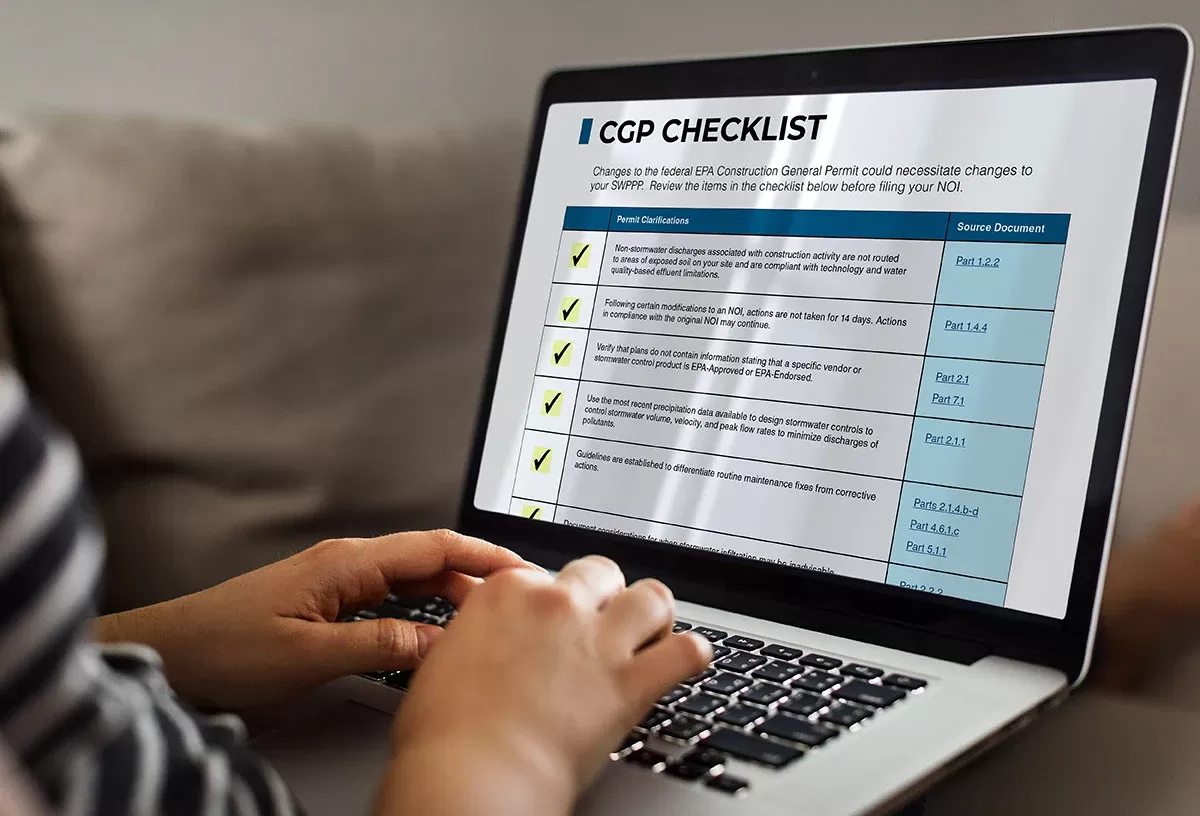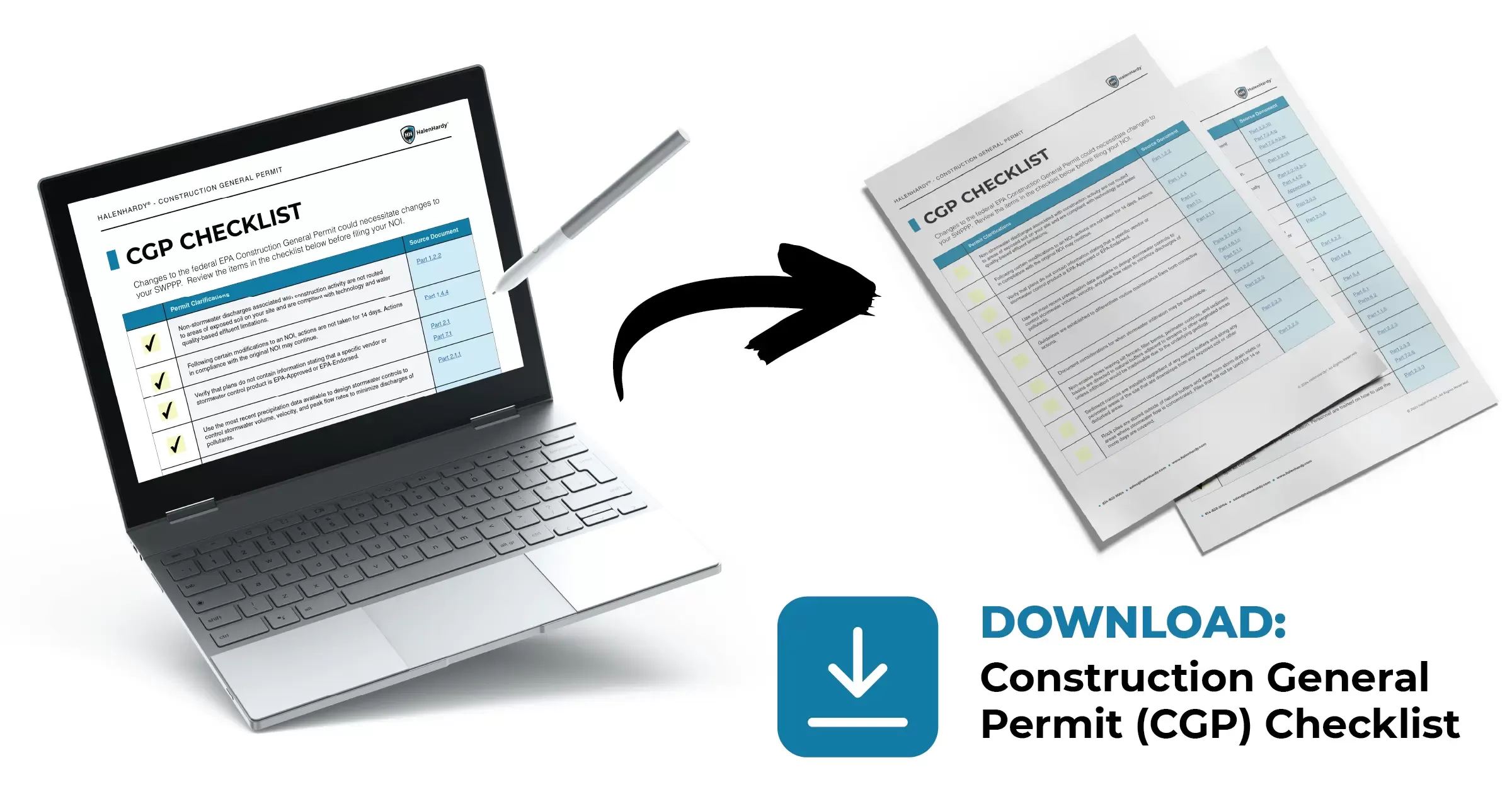

Construction General Permit (CGP) Checklist
Construction General Permit (CGP) Checklist
Our quick reference guide below helps you navigate EPA’s clarifications and updates. Also, be sure to download our interactive CGP checklist that makes it easy to review and update your SWPPP.
Permit Clarifications:
1 | Non-stormwater discharges associated with construction activity are not routed to areas of exposed soil on your site and are compliant with technology and water quality-based effluent limitations. (Part 1.2.2) |
2 | Following certain modifications to an NOI, actions are not taken for 14 days. Actions in compliance with the original NOI may continue. (Part 1.4.4) |
3 | Verify that plans do not contain information stating that a specific vendor or stormwater control product is EPA-Approved or EPA-Endorsed. (Part 2.1) and (Part 7.1) |
4 | Use the most recent precipitation data available to design stormwater controls to control stormwater volume, velocity, and peak flow rates to minimize discharges of pollutants. (Part 2.1.1) |
5 | Guidelines are established to differentiate routine maintenance fixes from corrective actions. (Part 2.1.4.b-d), (Part 4.6.1.c), and (Part 5.1.1) |
6 | Document considerations for when stormwater infiltration may be inadvisable. (Part 2.2.2) |
7 | Non-erosive flows leaving silt fences, filter berms, perimeter controls, and sediment basins are directed to natural buffers adjacent to streams or other vegetated areas unless infiltration would be inadvisable due to the underlying geology. (Part 2.2.2) |
8 | Sediment controls are installed upgradient of any natural buffers and along any perimeter areas of the site that are downslope from any exposed soil or other disturbed areas. (Part 2.2.3) |
9 | Rock piles are stored outside of natural buffers and away from storm drain inlets or areas where stormwater flow is concentrated. Piles that will not be used for 14 or more days are covered. (Part 2.2.5) |
10 | Drain inlet protection is provided unless stormwaters are conveyed to a sediment basin or similar control. (Part 2.2.10), (Part 7.2.4.g), and (Part 7.2.6.b.iv) |
11 | Provisions are outlined for the use of erosion control netting for site stabilization. (Part 2.2.14) |
12 | Inspection intervals are documented for arid and semi-arid areas during seasonally dry periods. (Part 2.2.14.b-c), and (Part 4.4.2), and (Appendix A) |
13 | Procedures are established for keeping waste containers with lids closed. (Part 2.3.3) |
14 | Procedures are established for handling liquid wastes from washing applicators or containers used for stucco, paint, concrete, form release oils, curing compounds, or other materials. (Part 2.3.4) |
15 | Schedules are established for inspections after rain and snow events. (Part 4.2.2) |
16 | The SWPPP site map is updated following site inspections to reflect any changes to stormwater controls. (Part 4.6.4) |
17 | Corrective actions are documented within 24 hours. (Part 5.4) |
18 | Names of stormwater team members are documented, and records of their training are accessible. (Part 6.1) and (Part 6.2) |
19 | The endangered species protection worksheet is completed. (Part 1.1.5) |
20 | Perimeter controls are installed as required, are effective, and repairs are conducted as needed. (Part 2.2.3) |
21 | Containers of petroleum products, pesticides, and other chemicals are properly stored with lids closed and secondary containment provided when applicable. (Part 2.3.3) and (Part 7.2.6) |
22 | Spill kits are available and in good condition. Personnel are trained on how to use the spill kit contents. (Part 2.3.3) |
23 | Waste remnants of certain non-polluting construction materials or products are properly stored. (Part 2.3.3), (Part 7.2.4), and (Part 7.2.6) |
24 | Proper controls are in place to prevent sediment and pollutant discharges during dewatering operations. Dewatering operations are specified in the NOI. Inspections occur during dewatering, and records of those inspections are kept. (Part 2.4), (Part 3.3), (Part 4.3.2), (Part 4.6.3), (Part 5.1.5), (Part 5.2.2), (Part 7.2.4), (Part 7.2.8), and (Appendix K) |
25 | Personnel conducting inspections have completed the EPA-developed training program, or an equivalent training program. (Part 4.1), and (Part 6.1) |
26 | Inspections include checking for signs of sedimentation and other pollutants that are visible from points of discharge from the site. (Part 4.6) |
27 | Photo documentation of the stabilized site is included as part of permit termination. (Part 8.2.1) |
28 | The NOI indicates: * if other operators involved in the same project are also covered under the CGP * if there are other operators who are also covered by the CGP at the same site and, if so, what their NPDES ID numbers are. * that any personnel conducting inspections will meet the training requirements. (Appendix H) |
Shop SWPPP Solutions
Additional Resources
TALK TO AN EXPERT
If you have a question about the 2022 Construction General Permit (CGP), we’re here to help. Our team can address your questions and assist in implementing changes to your SWPPP. Call 814-822-2004 or email sales@halenhardy.com.
